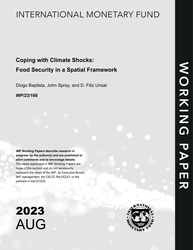
Coping with Climate Shocks: Food Security in a Spatial Framework
Coping with Climate Shocks: Food Security in a Spatial Framework
READ MORE...
Volume/Issue:
Volume 2023
Issue 166
Publication date: August 2023
ISBN: 9798400252884
$20.00
Add to Cart by clicking price of the language and format you'd like to purchase
Available Languages and Formats
| English |
Prices in red indicate formats that are not yet available but are forthcoming.
Topics covered in this book
This title contains information about the following subjects.
Click on a subject if you would like to see other titles with the same subjects.
Economics- Macroeconomics , Economics / General , Environmental Economics , Emigration and Immigration , Agriculture , Food Security , Trade , Migration , Climate change , Climate shocks , welfare loss , food consumption , migration cost , loss from climate , losses from climate change , Consumption , Migration , Income , Global
Also of interest
Summary
We develop a quantitative spatial general equilibrium model with heterogeneous house-holds and multiple locations to study households’ vulnerability to food insecurity from cli-mate shocks. In the model, households endogenously respond to negative climate shocks by drawing-down assets, importing food and temporarily migrating to earn additional income to ensure sufficient calories. Because these coping strategies are most effective when trade and migration costs are low, remote households are more vulnerable to climate shocks. Food insecure households are also more vulnerable, as their proximity to a subsistence requirement causes them to hold a smaller capital buffer and more aggressively dissave in response to shocks, at the expense of future consumption. We calibrate the model to 51 districts in Nepal and estimate the impact of historical climate shocks on food consumption and welfare. We estimate that, on an annual basis, floods, landslides, droughts and storms combined generated GDP losses of 2.3 percent, welfare losses of 3.3 percent for the average household and increased the rate of undernourishment by 2.8 percent. Undernourished households experience roughly 50 percent larger welfare losses and those in remote locations suffer welfare losses that are roughly two times larger than in less remote locations (5.9 vs 2.9 percent). In counterfactual simulations, we show the role of better access to migration and trade in building resilience to climate shocks.
Copyright © 2010 - 2026
Powered by:
AIDC



